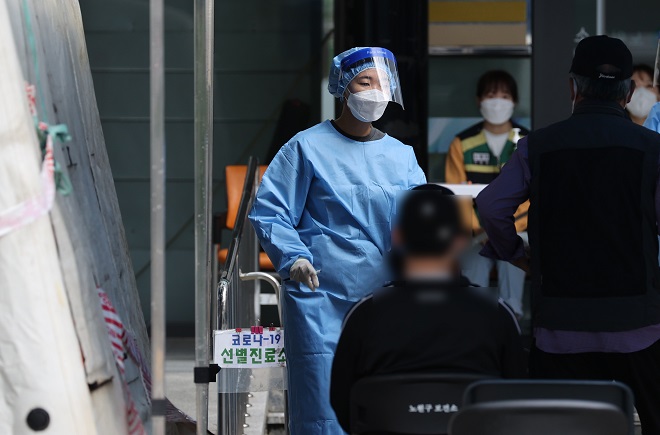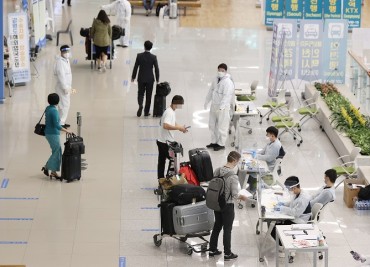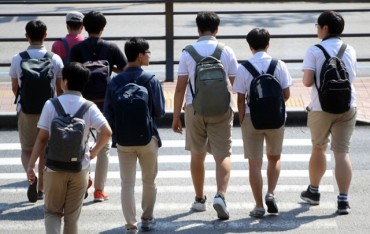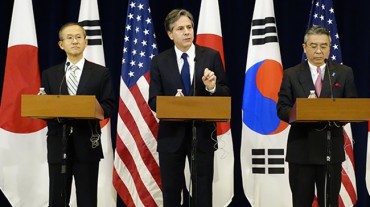
This photo, taken Sept. 8, 2020, shows health workers preparing to conduct coronavirus tests at a screening center in Seoul’s northern ward of Nowon. (Yonhap)
SEOUL, Sept. 9 (Korea Bizwire) — South Korea’s new virus cases stayed below 200 for the sixth consecutive day Tuesday, but sporadic cluster infections across the nation continued to put health authorities on edge.
The country added 136 more COVID-19 cases, including 120 local infections, raising the total caseload to 21,432, according to the Korea Centers for Disease Control and Prevention (KCDC).
It marked a slight increase from 119 additional cases reported Monday, the fewest in 24 days.
South Korea has been scrambling to contain a flare-up in virus cases as daily infections have been in the triple digits since Aug. 14 due to cluster infections tied to churches and a large-scale rally in central Seoul in mid-August.
New virus cases soared to a five-month high of 441 on Aug. 27, but they have been on a downward trend on stricter social distancing measures, which health authorities called a “positive” sign in the virus fight.
The KCDC said the enhanced social distancing scheme, called Level 2.5 measures, currently being imposed in the greater Seoul has begun to have an effect.
“A surge in new virus cases has been halted, and daily infections are slowing,” Kwon Joon-wook, deputy director at the Central Disease Control Headquarters, said in a daily briefing.
Kwon said the number of municipalities reporting no new cases has increased, and that of seriously and critically ill patients is gradually on the rise.
“Health authorities hope that after this week, new virus cases could markedly slow,” he added.

This photo, taken Sept. 8, 2020, shows a train carrying a small number of passengers stopping at Seoul Station in central Seoul. The Korea Railroad Corp. has decided to allow people to only reserve widow seats for the upcoming Chuseok fall harvest holiday to contain the spread of COVID-19. (Yonhap)
After the eight-day operation, the country extended the tougher virus curbs by another week Monday in the capital region, home to half of the country’s 51.6 million population, as virus cases spiked at an alarming pace.
Under the scheme, eating at restaurants and small eateries is only allowed until 9 p.m. Franchise coffee chains, bakeries and ice cream parlors are permitted to offer only takeout and delivery.
The country also extended its Level 2 social distancing measures across the country by another two weeks until Sept. 20 as cluster infections continued to pop up nationwide.
“The effect of the social distancing has become evident, with daily infections staying in the 100 range for six days in a row,” Yoon Tae-ho, a senior health ministry official, said in a briefing.
“In particular, new infections have been in the double digits for the second straight day in the Seoul area in an indication that the resurgence in virus cases has stabilized,” he said.
Health authorities said they will monitor the trend of the virus outbreak further to decide whether to extend the tougher virus curbs around the weekend.
Of the newly identified local infections, 67 cases were reported in Seoul and 29 from Gyeonggi Province that surrounds the capital. Incheon, just west of Seoul, reported two more cases.
Other municipalities reported new infections, with the southeastern port city of Busan adding one cases and the southwestern city of Gwangju reporting 12 new infections.
Cases traced to Sarang Jeil Church in northern Seoul, a hotbed of the recent spike in new infections, reached 1,167 as of noon, up four from the previous day.
The church-tied cases marked the largest cluster infection after more than 5,000 virus cases traced to the minor religious sect of Shincheonji were reported in Daegu in late February and early March.
Cases tied to the anti-government rally in Seoul on Aug. 15 rose seven to 539.
Sporadic cluster infections showed no signs of letup. Cases traced to a call center in eastern Seoul reached 22, up four from the day earlier. Infections tied to a Buddhist religious facility increased by 11 to 12.

Quarantine officials disinfect an agricultural wholesale market in the southwestern city of Gwangju to contain the spread of the new coronavirus on Sept. 8, 2020. (Yonhap)
Health authorities remain vigilant against a potential rebound in virus cases due to people’s movements during the upcoming Chuseok fall harvest holiday.
This year’s Chuseok holiday runs from Sept. 30 to Oct. 4. The Korean autumn harvest celebration is one of the country’s biggest traditional holidays and serves as a chance for family members to visit their hometowns.
The country, meanwhile, reported 16 imported cases, with four cases coming from India and another four from Turkey.
South Korea reported five more deaths, raising the death toll to 341. The fatality rate was 1.59 percent.
The number of seriously or critically ill COVID-19 patients reached 151 as of midnight, down 11 from the previous day.
Virus patients in their 60s or older accounted for 85.4 percent of such people.
Concerns about a shortage of hospital beds linger, as intensive care beds that can be used immediately reached five in the wider capital region and 37 across the nation, the KCDC said.
Health authorities said they plan to secure an additional 20 intensive care beds within this week.
The total number of people released from quarantine after making full recoveries stood at 16,636, up 339 from the previous day.
The country has carried out 2,066,078 coronavirus tests since Jan. 3.
(Yonhap)






